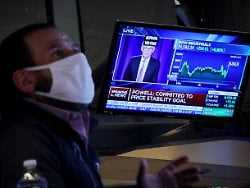Which ETF should it be?
A simple mix for stock market success
By Benjamin Feingold
02/05/2022, 08:19 am
In the long term, there is no way around stocks when building wealth. ETFs and index certificates convince as cost-effective solutions. However, popular indices such as the MSCI World are not always the best choice.
A lot of money is involved: all in all, private households in Germany are richer than ever. According to the Deutsche Bundesbank, financial assets were recently around 7.4 trillion euros. However, many households continue to park their money in a current account or savings account. But more and more people are finding their way to the stock market – and are looking for a simple and easy-to-implement strategy.
So-called ETFs (Exchange Traded Funds) and index certificates are ideal, with which you can invest widely and inexpensively in an index such as the Dax in one fell swoop. Papers on the MSCI World have seen particularly high inflows of funds in recent years. At first glance, this is a clever strategy, because the “World Index” contains around 1,600 stocks from 23 countries. In this way, investors spread the risk very broadly across different regions, which should have a positive impact on performance in the long term.
In the past few years, the calculation has worked particularly well because the large US stocks have risen sharply and US stocks are heavily weighted in the MSCI. The term “world index” is therefore not entirely accurate. If you invest around 1000 euros in the MSCI World, you are investing almost 700 euros on the American stock market. Apple alone is represented in the index with a weighting of 4 percent, Microsoft is behind you, Google’s mother Alphabet has 2.8 percent and Tesla 1.5 percent.
Apple stronger than Canada
To put this into context: At the country level, Japan follows in second place with 6.5 percent, Great Britain with a good four and Canada with 3.4 percent. Apple’s influence is thus greater than the contribution of the fourth largest country in the index.
Up-and-coming emerging markets like China are not represented at all. However, investors can get them in their portfolio with a paper on the MSCI Emerging Markets. China is now well represented there after opening up its capital markets in recent years. The index also includes the shares of the largest emerging market companies.
The high dependency on Wall Street has been a key reason for the success of the MSCI World for decades. However, investors who already rely on the US technology barometer Nasdaq 100 with ETFs and index certificates and are also invested in the MSCI Word should consider making adjustments to reduce their heavy dependence on US stocks.
Europe’s stocks with potential
Promising stocks and indices for a good portfolio mix can also be put together in other regions. Paul Quinsee, global head of equities at wealth manager JP Morgan Asset Management, still sees a lot of potential in equities despite the recent turmoil around the world. Second-line stocks and European stocks, which are “overall very cheaply valued,” are promising. Therefore, ETFs or index certificates on European stock indices such as the domestic Dax or the large European index “Stoxx Europe 600” also belong in a balanced basic stock portfolio.
In addition, portfolio supplements can be made, as Nicolai Tietze, derivatives expert at Morgan Stanley, explains: “Index certificates on future topics can definitely represent an addition to the portfolio”. These include promising stock market topics such as artificial intelligence, the environment, telecommunications and digitization. Global stock coverage via the MSCI World, the MSCI Emerging Markets and the Stoxx Europe 600 are ideal as core investments in order to supplement the stock portfolio with satellites on future-oriented investment themes.
Benjamin Feingold operates the stock exchange portal Feingold Research.
This post is not a recommendation to buy or sell individual shares, ETFs or other financial products. No liability is assumed for the correctness of the data.
